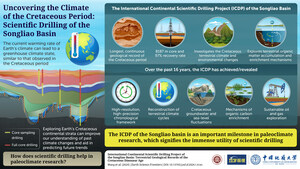Researchers Construct Himalayan-Tibetan Plateau Formation in Earth Science Frontiers Study
Chinese scientists use 'deep seismic reflection profiling' to uncover the fine details of continental collision and solve a decades-long mystery
BEIJING, Nov. 26, 2021 /PRNewswire/ -- Home to some of the highest mountains in the world–including the legendary Mount Everest–the vast Himalayan-Tibetan plateau is often referred to as the "Roof of the World". This plateau is one of the most representative instances of intercontinental collision. Geophysicists have long believed that it is the ideal playground to study and untangle continental convergence, and thus plate tectonics. To that effect, scholars have been conducting seismic tests in the area since the 1950s.
Now, Chinese scholars have published a study in Earth Science Frontiers, describing the structure of the crust under the Himalayan-Tibetan plateau, as well as the deep behaviors underlying the ongoing India-Eurasia collision. "The Himalayan-Tibetan plateau can be considered a sort of Rosetta Stone to unlocking the mysteries of continent-continent collision. The area can be regarded as the natural laboratory to investigate the phenomenon," says Professor Gao Rui of the Sun Yat-sen University, first author of the study.
The study utilizes a method called deep seismic reflection profiling to determine the fine architecture within the Tibetan Plateau. The technique involves sending artificially generated sound waves into the ground, where they meet different objects and structures which bounce back a portion of the sound waves. These sound waves are then detected and recorded on the surface and processed to develop a visual of the underground structure. The enormous size of the Tibetan Plateau, its height, and its inclement weather conditions are all factors that have contributed to the scale and difficulty of this daunting task.
Chinese scholars studied the Tibetan Plateau using deep seismic reflection profiling for over 20 years, overcoming several technical difficulties and bottlenecks to access the lowermost layer of the crust and the Mohorovicic discontinuity, or Moho.
Their discoveries can be summarized in four points. First, the Indian crust is experiencing northward subduction while its lower layers are varying in their thickness. Second, the subducting front of the Indian crust is in deep contact with the lower crust and the mantle 'suture' of the Eurasian plate. Third, a crustal-scale vertical collision occurred between two regions of the Plateau, the Tethyan Himalayas and the Lhasa terrane. Finally, the Eurasian plate is subducting in a southward direction under the Qilian Mountains, resulting in a northward advancement of the Qilian crust.
Of their findings, Prof. Gao says, "What makes the Himalayan-Tibetan Plateau so unique? Our study has the answers to that question. It also makes an enormous contribution to our understanding of the construction of continental orogenic range-basin systems."
The results of the study are sure to bring 'seismic' change in our understanding of the Earth's crust!
Reference
Title of original paper: Deep seismic reflection evidence on the deep processes of tectonic construction of the Tibetan Plateau
Journal : Earth Science Frontiers
DOI: https://doi.org/10.13745/j.esf.sf.2021.8.10
Media contact:
Xiaolong Wang
[email protected]
1-352-226-2702
SOURCE Earth Science Frontiers

WANT YOUR COMPANY'S NEWS FEATURED ON PRNEWSWIRE.COM?
Newsrooms &
Influencers
Digital Media
Outlets
Journalists
Opted In





Share this article